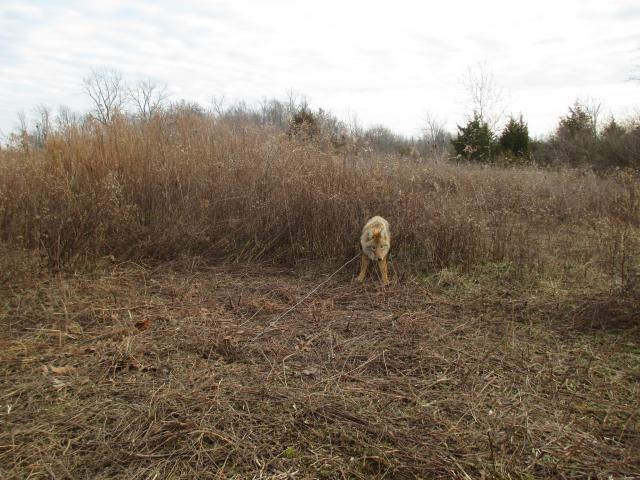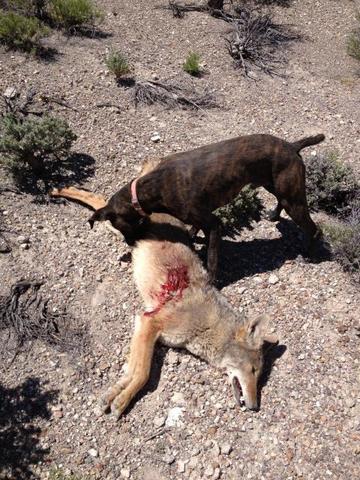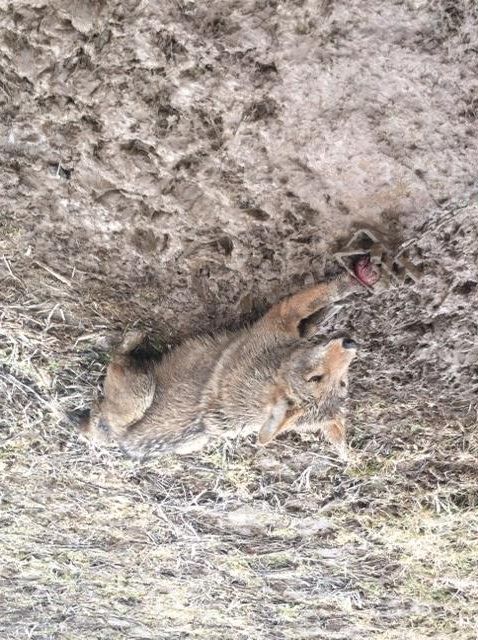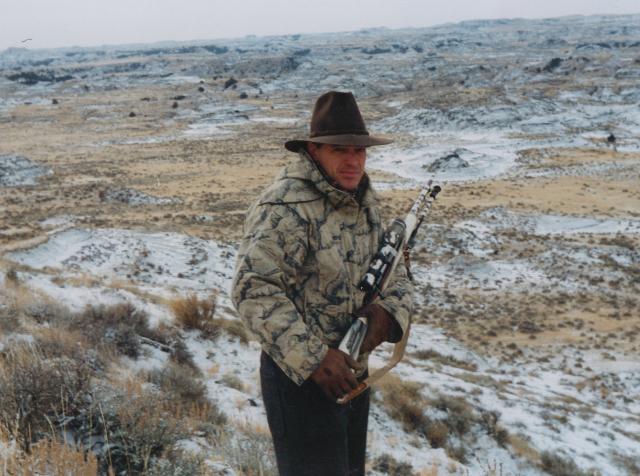Let's talk about locating denning areas and picking up the coyote before they have the pups.
Anyone on here have any denning experience ?

Lt:
Here is a draft of an article I wrote a while back and never submitted for publishing. It might help some guys figure out the denning thing.
The Toyota pickup coasted to a halt on the little-traveled two-track road. It was a moonlight night in late May but the light in the eastern sky signaled the approaching morning would soon be here. Before opening the truck door, I listened out the window for the sound of a coyote howl. Only a tiny breeze greeted my ears. I stepped out of the truck with my siren in one hand and my Primos Alpha Dogg electronic caller in the other. I set the e-caller on the roof of the truck and walked down the road several hundred yards. I lit up the siren and when it reached its peak “wind up,” I began to wave it back and forth, left and right, and up and down to vary the pitch and volume of the sound. After 20 seconds, I flicked off the switch abruptly and listened again. Silence.
Now I hit the e-caller with my selection of “coyote pup frenzy” and unleashed a chaotic collection of howls, yaps, yips, barks and bellows characteristic of a group of rank amature coyote howlers. After 20 seconds of that racket, I cut the noise off and listened. Nothing. Then, after a few moments, off in the distance and to the west came the response of a pair of coyotes. The gruff bark-howl of the male was easy to recognize, as was the high pitched yipping of the female. Digging my boot heel into the roadside gravel, I carved a rough line in the dirt pointing directly where I thought the sound was coming from. I then listened again, trying to visualize in my mind how far away the coyotes were, given the type of terrain, and the effect of the light wind. I also assessed the sound they were making and tried to interpret what it meant. My best guess was the pair was a half mile out, due west. Using a can of bright orange spray paint, I colored the line I had previously drawn in the dirt with my boot heel, and beside the line, scrawled “1/2.”I saved the location on my GPS unit in the truck and then headed down the road to see if I couldn’t locate another pair of talkative coyotes.
Every spring, I try to locate and take a few coyote dens. Coyotes with pups to feed are particularly destructive to domestic sheep and cattle, so ranchers are glad to have them removed. Moreover, coyotes give birth to pups in synch with the birthing of other big and small game mammals, like mule deer, antelope, bighorn sheep, elk and the like. If you find an active coyote den you will generally find the remains of many deer and antelope fawns, lambs, and a host of other deceased critters, depending on your location. Government trappers learned long ago that taking a coyote den will almost always eliminate or greatly reduce the killing of livestock or big game animals. My own observations suggest that coyotes can and do take bobcats so I don’t mind removing them from my bobcat trapline areas. Of course, you should check your local wildlife laws for seasons and methods of taking coyotes.
To locate a den of coyotes on a consistent basis can often be a bit of a puzzle. However, there are some general guidelines that will help you find dens with greater frequency. First, you absolutely need to understand coyote vocalizations at this time of year. Coyotes aren’t out there in the darkness just making random noises – there is a message with each vocalization and the better you understand what coyotes are saying during the denning season, the more likely you will be to locate their den.
SPEAKING COYOTE
The easiest way to locate a den is after the pups are able to leave the den for short periods of time, usually around the middle to end of May in most parts of the country. Northern latitudes will be later, and southern areas may be sooner, but by the end of May the pups will have started to periodically leave the den and they will become vocal. This is the ideal time to cruise back roads and other likely areas and howl after dark in the evening or before daylight. There are a host of mouth blown calls and electronic calls that will reproduce a coyote howl. There are two basic howls to master. The first is the male interrogation howl. It’s just a basic howl; it starts with mid pitch and gets slightly lower, tapering off without much variation or quivering in the notes. It sounds a bit like what you might think a timber wolf howl would sound like.
The other basic howl is a female invitation howl. Females are generally higher in pitch, and they have greater variation in tone, or what I call quivering notes. Their howl is often much more “choppy” instead of the longer notes of the male. Bill Austin, the famous Wyoming coyote caller used to refer to it as a “ki-yi.” It consists of several short barks, and then a drawn out note, sometimes with a quivering variation near the end.
Either of these two howls will generally get pups to vocalize if they are old enough. You will recognize pups because they will be extremely high pitched, choppy and it will sound like a dozen all sounding off at once. Mark that location in your mind. Try to visualize how far away they are and in what direction. If you are familiar with the terrain, try to visualize where a den may be located – usually in a dirt bank, rock pile, patch of sage, prominent point of ground, old badger diggings, or sand blow. Most den sites are on a slight elevation, or if they are in flat terrain, they will have a little elevation nearby like a small hill, a rise, or bluff where the parents can keep an eye on things. Try to get some bearings or pick a landmark that will guide you when you come back in the daylight to locate the den. When I howl at night, I usually pick out a mountain peak or old farmhouse light on the horizon. I will also mark the location on my GPS, and then I get a can of bright orange marking paint and spray paint a line on the ground pointing to where I think the sound came from. I may also mark on the ground the distance I estimate the den is located.
Of course, if pups aren’t old enough to be vocal yet, you will have to use some other techniques, and this is where learning coyote language is essential. If you are howling at night, the parents are generally off hunting somewhere. If they answer you, it establishes that a pair of coyotes is in the same general area, but doesn’t do much to help you locate a den. The pair may give one of several responses. They may just howl back at you, with what my friend Jack Spencer calls a “happy howl.” It’s just an acknowledgment by the pair that they have heard you. Numerous studies have determined that coyotes recognize specific individuals based on voice recognition. These studies have also shown that a pair of coyotes will vocalize on hearing other coyotes in their home territory in order to alert the “new” coyotes to the idea that this area is currently being occupied. If you hear this “happy howl,” odds are that a den is quite a distance away.
On the other hand, if you get a defensive vocalization from the pair (and it usually happens as a pair), you know you are within the boundary the pair of coyotes has staked out as their denning area and against which they will defend all intruders. In my experience, you are within a quarter mile or so of the den, maybe more, maybe less. The defensive vocalizations of coyotes are easy to distinguish. The male makes a real deep, gruff, bark-howl. It is choppy, short and means he’s ready to kick you out of his neighborhood. The female makes her usual ki-yi, only it is shorter, more agitated and more frequent than her usual howl. The pair of coyotes I located at the beginning of this article were obviously giving me the defensive communication that told me they weren’t about to let another coyote enter their area without a fight. It also told me they were very close to their den.
If you get a defensive pair responding to your nighttime calls, a good way to verify the existence of a den is to come back after 8:00 am in the morning and give a few more howls. If the adults are back from their nightly hunting excursion and on their den, they will respond with the threatening howls that make it clear they are defending a territory. By the way, don’t overdo the calls. Less is more. I usually only howl twice and then I listen for several minutes before howling twice more. Ray Alcorn, a pioneer in the field of understanding coyote vocalizations in the 1940's, determined coyotes will go silent after initially responding to a call, and it usually took about 25 minutes of silence before they would again respond to a call. If I get no response to the second set of howls, I go look for coyotes elsewhere.
My friend Joe Bennett educated me to the idea of separating my two different sounds when trying to locate coyotes. If you hunt with a buddy, drop him off with the siren, and you take the other noismaker (either an e-caller or hand call) and go an 1/8th of a mile or more down the road. Then have your buddy run the siren for 15-20 seconds and stop. After a brief moment of silence to determine whether or not anything answered the siren, you go ahead with a lone interrogation howl, or better yet, let loose with the “puppy frenzy group howl chorus.” For some reason, the coyotes just can’t resist this coordinated vocalization and will almost always join in with their own noises. You also have the added benefit of having two perspectives as to the direction, distance and characteristics of the response you get so that you can sort of triangulate the points of reference. Believe me, it makes pinpointing the location of a pair of coyotes so much easier and more accurate.
USING TRACKS AND SIGN TO LOCATE DENS
If you don’t get any responses to your howling inquiries, it could mean that no coyotes are present, or they are out of hearing at the time, preoccupied with other matters, or they may be one of those odd pairs that just refuse to vocalize. There is a golf course near my home and my friends kept telling me about constantly seeing coyotes out on the golf course. I spent a half dozen nights and mornings around that golf course howling and using my siren but got no response. One day my son played that golf course and said he heard a coyote to the north east of the course, about a half mile out. I was able to quickly locate that den once I had a little help knowing which direction to start looking for it. This pair of coyotes just wouldn’t answer my calls. Ray Alcorn’s studies also showed that not every coyote will respond to a howl or a siren, so the lack of coyote vocalizations does not always mean coyotes are not present.
If the coyotes are of the silent variety, you will have to use tracks and scat to tell you whether there are coyotes present or not. Coyotes need water for themselves and their young in the hot summer months so most dens I find are within sight of water . . . it may be a mile away, but water is essential. In the western United States, this will help you narrow down your search. Another good place to look is near crops, like alfalfa, grains, meadows and pastures. Coyotes will generally lead their pups to those areas so they can learn to mouse and hunt for themselves. Also check dirt roads, saddles, horse or deer trails, fence corners or anywhere else you can find tracks or sign. Fresh droppings on a dirt road will usually indicate a boundary marker and are worth checking out. Ask farmers, ranchers or other locals if they have heard or seen coyotes lately and follow up in those areas. I have found dens by remembering where I saw young coyotes hit on the highway in years past.
APPROACHING THE DEN
Once you think you have a bead on where the den is located generally, it’s time to plan your approach. I usually don’t drive closer than 400 yards from the den. Approach the den by walking into the wind. Use your binoculars as you will often find an adult coyote loafing around near the den. I don’t usually approach the den until 8:00 am or later. Any earlier in the day than that, and you run the risk of the adults being out hunting and not near the den.
If you have a dog that you can control somewhat, take him or her with you. Coyotes are extremely territorial near their dens and the adults will focus on your dog and generally disregard your presence. I like to sneak in with the dog to where I think the den is. If I have done my homework, I will start to see increased coyote traffic and sign. There will usually be a host of trails that lead to and away from the den, sort of like the spokes of a wheel with the den being the hub. Pay particular attention to the coyote tracks you see. Tracks in a straight line usually lead to the den, while those of a more wandering nature are generally tracks leading away from the den. You should also start to see a lot of droppings, and fresh diggings where the adults have dug out a cool spot to rest in the shade or just lay around. You may also find other holes called “cleanouts.” These are potential or previously used den sites that the coyotes have excavated and where they will take their pups once the current den hole is fouled with old carcasses or over run with fleas.
Once you are confident you are on target, get as close to the den as you think you can get without being seen, and then set up. I use a high-powered .22 center fire rifle with a bi-pod. When I’m all set, I generally make one brief male interrogation howl just as an attention getter and turn my dog loose. After a moment or so, I start in with a coyote pup in distress call. Here is where it can get Western in a hurry. If you are on top of the den location, you can expect an immediate response from the adults. They may stand back and just bark at you, or they may come on the run and attempt to chase your dog away.
The hunt I described at the beginning of this piece was one of the more classic Western varieties. I had howled and located coyotes from sundown to sunrise across two counties in the high sage country of central Nevada. I had been fortunate in that I had located several good den sites, and had taken a pair of coyotes and a den earlier that morning. By the time I got back to this pair of coyotes it was after lunch. I came back to my marker on the side of the road and reflected again on what I had heard in the darkness, reminding myself of the distance and direction of the coyotes. I then loaded my rifle, donned my pack and let my dog Buddy out of the truck.
Buddy is a two year old cur dog I was fortunate to get as a pup from a government trapper. This is his first full season of denning and he’s just starting to figure it all out. We hiked along through the brush to where I figured the coyotes had been calling from, between two small knolls in the loamy ground. Between the two mounds was a thicket of high sage and bitterbrush. My guess was the den was in that thicket. I started to cross a small patch of barren alkali ground when Buddy spied a big jackrabbit and gave chase, yipping as he went crashing through the brush. Instinctively, I froze. Not 75 yards away a female coyote had materialized in the brush and was looking me over. I remained motionless, then started to almost giggle at the thought of a 6'3" man standing bolt upright in the middle of open ground as barren as a pool table top, trying to hide.
Despite the humor of the situation, I forced myself to watch the female. She kept staring back over her left shoulder, about 45 degrees away from me and toward the densest part of the sage thicket. Bingo! She was showing me where the den was. After what seemed like ten minutes she faded away in the brush. I hurried to the edge of the clearing, got my gun cocked and rested on my shooting sticks. I quickly started a puppy in distress call on the e-caller. Just then Buddy returned from his rabbit chase and trotted across the little clearing on his way back to me. From out of the brush on the edge of the clearing a brown form shot from the sage and T-boned poor old Buddy – the male coyote had arrived!
The big dog coyote was fighting mad. He barked at the now thoroughly frightened Buddy and began to kick sand with his back legs, barking as he did so. Buddy couldn’t get behind me fast enough. The big coyote was only 25 yards from me and directly down wind so I have little doubt he knew I was there but he was so enraged that this upstart domestic canine cousin had trespassed in his denning area, he ignored the clear and present danger. The little female coyote came out of the brush and trotted up one of the little knolls. As she stopped, I sent a 55 grain softpoint right behind her front leg. She immediately dropped. The big dog coyote ran for the safety of the high sage but I knew he would be back. Emboldened by the report of the gun and seeing the female drop, Buddy ran to the downed coyote and began to sniff the now lifeless female. It was more than the big male could stand and he foolishly trotted up the other knoll to get a better view of Buddy, all the while giving his gruff barking threats. He soon joined his mate in the Happy Hunting Grounds.
This little story underscores some of the key points to watch out for when calling and decoying coyotes. Pay close attention to the direction the coyotes came from and how long it took them to get there. This will be critical in later trying to find the den. Keep up the puppy-in-distress calls. Single out the female and watch her. She will generally be the smaller and less aggressive of the pair. She may also have a dark belly from where she has nursed. Watch her. She will almost always look back in the direction of the den. The male will be larger and is almost always the more aggressive coyote, often kicking dirt with his hind legs and constantly barking. He will be looking back at the female, who will almost always be checking out the den location.
Shoot the female first as the male will almost always come back to you, especially if you have a dog. The dog doesn’t have to do anything in particular except be seen. If he will chase the coyotes a little bit, so much the better, but you don’t want a dog that will chase them clear out of the country. Once the male reappears, take him. Now it’s time to go find the den.
I generally rely on the female to give me clues as to the location of the den but this isn’t always as helpful as it sounds. In thick vegetation or boulder-strewn slopes, it can still be difficult. If a pair of coyotes has been aggressive with your dog, you are near the den and then it’s just a matter of looking in the right places. I look first for cut banks or ditches as coyotes seem to prefer them. In northern climates coyotes often like a southern exposure for their dens; in the southwest desert they are often on the north slope of a ridge. Look under rocks or ledges; in old woodchuck or badger diggings; sometimes the tallest thicket or sage patch is where the den is located. Frequently there will be several den holes and you will have to determine which one the pups are located in at the time. Tracks or sign near the den, with little wet “pee spots” are a good indication. Also, flies buzzing around the den hole indicate a hole is occupied. Sometimes you can move back (taking your dog with you) and coax the pups out with some soft coyote whines or barks.
Denning coyotes can be fun and exciting, but I feel a couple of cautions are in order. First, the true “denning” period for coyotes is actually pretty short, about 4-5 weeks. By about the middle or end of June, the pups have left the den and will roam around in the brushy areas near the old den. If the pups have left the den, you can sometimes call them to you with a rabbit in distress call.
Second, let me disabuse you of the inclination to take a coyote pup home and try to tame it. With rare exception this always turns out bad for everyone. I’ve had a bunch of coyotes that were taken even before their eyes were open and they all became “wild as a March hare,” as my grandmother would say. They are coyotes from birth – the fact that you take them home with you doesn’t take any part of the coyote out of the animal. Most state laws have what is called “strict liability” for bites from a dangerous animal like a coyote. This means you are absolutely liable for any injuries caused by the animal, so be forewarned.
Third, try to leave the den intact as coyotes will generally reuse it from year to year. If you do have to dig up a den, BE CAREFUL OF CAVE INS. Never dig a den alone. I can’t imagine a more horrible death than being stuck in a coyote den when it collapsed, miles from nowhere and without anyone knowing where you are.
Finding coyote dens is a challenging exercise and takes a lot of skill, patience and ambition. You will end up doing a lot of walking and hiking in order to consistently locate den sites. But the things you will learn about coyotes, their behavior, their family structure and their habits during the denning process will make you a better coyote trapper and will be of great benefit to big game populations and cattle. Be safe and have fun with it.








